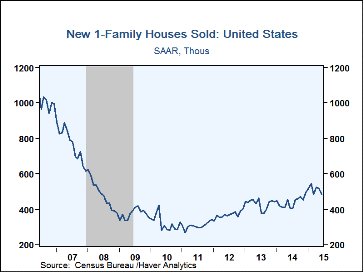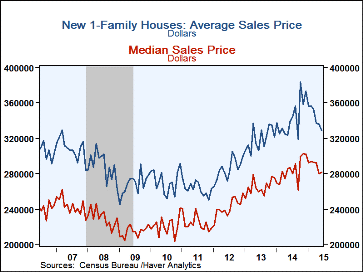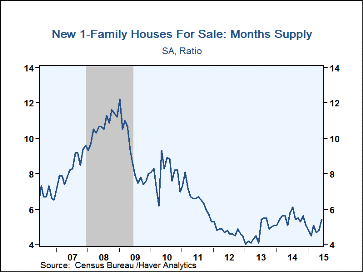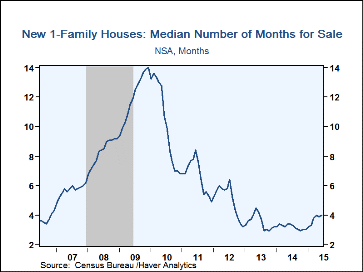 Global| Jul 24 2015
Global| Jul 24 2015U.S. New Home Sales Unexpectedly Decline as Pricing Power Wanes
by:Tom Moeller
|in:Economy in Brief
Summary
New home sales during June declined 6.8% to 482,000 following a revised 1.1% May drop to 517,000, initially reported as 546,000. April sales also were revised lower to 523,000 from 534,000. Sales were at the lowest level since [...]
New home sales during June declined 6.8% to 482,000 following a revised 1.1% May drop to 517,000, initially reported as 546,000. April sales also were revised lower to 523,000 from 534,000. Sales were at the lowest level since November and 11.6% below the February peak of 545,000. The latest decline contrasts with Wednesday's report of a 3.2% rise in sales of existing homes. The latest figure disappointed expectations for 549,000 in the Action Economics Forecast Survey. Sales are quoted at seasonally adjusted annual rates.
Home prices remained under pressure. The median price for a new home during June improved a scant 0.5% (-1.8% y/y) to $281,800. May's median price was revised down, however, to $280,500 from $282,800. June's price was 6.9% below the peak of $302,700 reached in November. The average price of a new home declined 2.1% last month to $328,700 (-2.8% y/y) from $335,900 in May. The latest was down 12.0% from the December peak.
Sales results continued to vary around the country. In the West, sales declined 17.0% from May to 112,000 (+10.9% y/y). It was the lowest sales level since last July. Sales in the Midwest were off 11.1% (+5.7% y/y) to 56,000, the least since February. Sales in the South fell 4.1% to 282,000 (+23.7% y/y), the lowest level since December. To the upside, sales in the Northeast posted a 28.0% gain (23.1% y/y) to 32,000. They remained, however, 15.8% below the peak reached in May of last year.
The inventory of unsold homes increased to 215,000 (8.6% y/y). The months' sales supply of new homes also increased m/m to 5.4 months, the highest level since November. The length of time to sell a new home nudged up from June to 4.0 months but was down from 14.0 months at the end of 2009.
The data in this report are available in Haver's USECON database. The consensus expectation figure from the Action Economics survey is available in the AS1REPNA database.
Millennials, Baby Boomers, and Rebounding Multifamily Home Construction from the Federal Reserve Bank of Kansas City is available here.
| U.S. New Single-Family Home Sales (SAAR, 000s) | Jun | May | Apr | Jun Y/Y % | 2014 | 2013 | 2012 |
|---|---|---|---|---|---|---|---|
| Total | 482 | 517 | 523 | 18.1 | 439 | 429 | 369 |
| Northeast | 32 | 25 | 14 | 23.1 | 28 | 30 | 28 |
| Midwest | 56 | 63 | 71 | 5.7 | 60 | 62 | 48 |
| South | 282 | 294 | 316 | 23.7 | 244 | 232 | 194 |
| West | 112 | 135 | 122 | 10.9 | 108 | 106 | 97 |
| Median Price (NSA, $) | 281,800 | 280,500 | 292,000 | -1.8 | 283,775 | 265,092 | 242,108 |
Tom Moeller
AuthorMore in Author Profile »Prior to joining Haver Analytics in 2000, Mr. Moeller worked as the Economist at Chancellor Capital Management from 1985 to 1999. There, he developed comprehensive economic forecasts and interpreted economic data for equity and fixed income portfolio managers. Also at Chancellor, Mr. Moeller worked as an equity analyst and was responsible for researching and rating companies in the economically sensitive automobile and housing industries for investment in Chancellor’s equity portfolio. Prior to joining Chancellor, Mr. Moeller was an Economist at Citibank from 1979 to 1984. He also analyzed pricing behavior in the metals industry for the Council on Wage and Price Stability in Washington, D.C. In 1999, Mr. Moeller received the award for most accurate forecast from the Forecasters' Club of New York. From 1990 to 1992 he was President of the New York Association for Business Economists. Mr. Moeller earned an M.B.A. in Finance from Fordham University, where he graduated in 1987. He holds a Bachelor of Arts in Economics from George Washington University.










